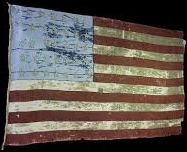While many of us have heard our flag called “Old Glory” few of us know how that nickname came to be. It was August 1831 when a young seaman from Salem, Massachusetts was given command of his own ship the “Charles Doggett.” The seaman’s name was William Driver and he had just turned 21 years old. In honor of his birthday and his recent promotion to Captain, his mother and a few friends presented him with a hand sown American flag to be flown on his ship.
The flag having 24 stars was flown from the ship’s mast. When it was unfurled Captain Driver is reported to have said, “my ship, my country, and my flag.” He then began calling his flag “Old Glory.” Captain Driver sailed the seven seas for over twenty years. He sailed to China, India, Gibraltar and throughout the South Pacific. On his first voyage he carried survivors from the HMS Bounty from Tahiti to Pitcairn Island, all under his precious American flag.
After the death of his wife, Captain Driver gave up the sea and moved his family to Nashville, Tennessee in order to be near his three brothers who owned a store there. After moving to Tennessee, he flew the flag each morning from the third-floor window of his home during rain or shine. The flag was large, 17 feet by 10 feet. Being so large, the flag became well known throughout the city of Nashville.
As grumblings of secession began to grow in the South, Captain Driver continued to fly “Old Glory.” After Tennessee seceded from the Union, Governor Isham G. Harris sent a committee to Captain Driver’s home and demanded that he hand over his flag. Captain Driver met the group of men at his door stating, “if you want my flag, you’ll have to take it over my dead body.” The committee retreated, failing in their mission. Captain Driver then hid his flag by sewing it inside his bed’s coverlet (quilt).
During the war, no flag became a symbol of Union loyalty more than the worn and imperiled standard belonging to Captain Driver. His defiant flying of the flag at the beginning of the conflict had become national news.
During the Civil War citizens became passionate about their flags. After the surrender of Fort Sumpter, its garrison flag toured the country for the duration of the war. The poet Walt Whitman shared his love for the flag in a letter to his mother. He wrote, “I have a little flag (it belonged to one of our cavalry regiment) presented to me by one of the wounded. It was taken by the [Confederates] in a cavalry fight & rescued by our men in a bloody little skirmish. It cost three men’s lives, just to get one little flag, four by three. Our men rescued it & tore it from the breast of a dead rebel. All that just for…getting their little banner back again.” Walt Whitman’s love for the American flag can be seen in many of his poems.
Old Glory remained hidden inside Captain Driver’s quilt until February 1862 when members of the Union Army’s Sixth Ohio Regiment entered Nashville and captured the city from the Confederates. One of the first things the Union troops did was raise a small American flag over the capitol building in Nashville. Union sympathizers in Nashville remembered Captain Driver’s flag and asked that it be flown over the capitol building in place of the smaller flag being flown.
Captain Driver, now 58 years old, contacted the Union Commander, General William “Bill” Nelson, stating triumphantly and with tears in his eyes, “This is the flag I hope to see hoisted on that flagstaff in place of that dammed Confederate flag set there by that damned rebel governor, Isham G. Harris. I have had hard work to save it; my house searched for it more than once.”
When asked why he called his flag Old Glory, he stated, “Savages and heathens, lowly and oppressed, hailed and welcomed it at the far ends of the wide world. Then why should it not be called Old Glory?”
Captain Driver, a true and loyal American, died on March 3, 1886 and is buried in Nashville, Tennessee. The monument over his grave site, which he designed himself, is that of a broken tree trunk with an anchor attached. The inscription reads, His Ship, His Country, and his Flag. Old Glory.”
Today used as a colloquialism referring to all American flags, Old Glory was once the name given to a sailor’s beloved ensign. Old Glory is on display in the Tennessee State Museum. The National Museum of American History has deemed Old Glory a historic flag artifact second in importance only to the American flag flown over Fort McHenry during the War of 1812 and immortalized by Francis Scott Key in his poem, The Star-Spangled Banner.





